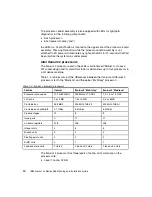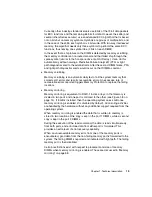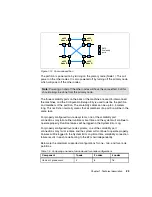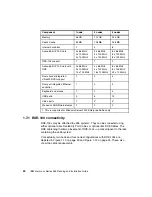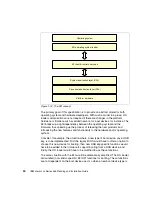
Chapter 1. Technical description
15
Currently, other industry-standard servers use 8 bits of the 72-bit data packets
for ECC functions and the remaining 64 bits for data. However, the x455 (and
several other xSeries servers) use an advanced ECC algorithm that is based
not on bits but on memory symbols. Symbols are groups of multiple bits, and
in the case of the x455, each symbol is 4 bits wide. With two-way interleaved
memory, the algorithm needs only three symbols to perform the same ECC
functions, thus leaving one symbol free (2 bits on each DIMM).
In the event that a chip failure on the DIMM is detected by memory scrubbing,
the memory controller can re-route data around that failed chip through the
spare symbol (similar to the hot-spare drive of a RAID array). It can do this
automatically without issuing a Predictive Failure Analysis® (PFA) or light
path diagnostics alert to the administrator. After the second DIMM failure, PFA
and light path diagnostics alerts would occur on that DIMM as normal.
Memory scrubbing
Memory scrubbing is an automatic daily test of all the system memory that
corrects soft errors and reports recoverable errors. An excessive rate of
recoverable errors reported triggers Memory ProteXion to replace the failing
locations.
Memory mirroring
Memory mirroring is equivalent to RAID-1 in disk arrays, in that memory is
divided in two ports and one port is mirrored to the other (see Figure 1-8 on
page 14). If 8 GB is installed, then the operating system sees 4 GB once
memory mirroring is enabled (it is disabled by default). All mirroring activities
are handled by the hardware without any additional support required from the
operating system.
When memory mirroring is enabled the data that is written to memory is
stored in two locations. One copy is kept in the port 1 DIMMs, while a second
copy is kept in the port 2 DIMMs.
During the execution of the read command, the data is read simultaneously
from both ports, and error-free data from either port is forwarded. This
provides an extra level of error recovery capability.
When an unrecoverable memory error from one of the memory ports is
encountered, good data from the non-failing memory port is forwarded to the
system. The failing DIMM is reported and indicated with light path. The failing
memory port is then disabled.
Certain restrictions exist with respect to placement and size of memory
DIMMs when memory mirroring is enabled. These are discussed in “Memory
mirroring” on page 58.
Summary of Contents for 88553RX
Page 2: ......
Page 214: ...200 IBM Eserver xSeries 455 Planning and Installation Guide Figure 5 14 Connect to the x455...
Page 228: ...214 IBM Eserver xSeries 455 Planning and Installation Guide...
Page 229: ...IBM Eserver xSeries 455 Planning and Installation Guide...
Page 230: ......
Page 231: ......










